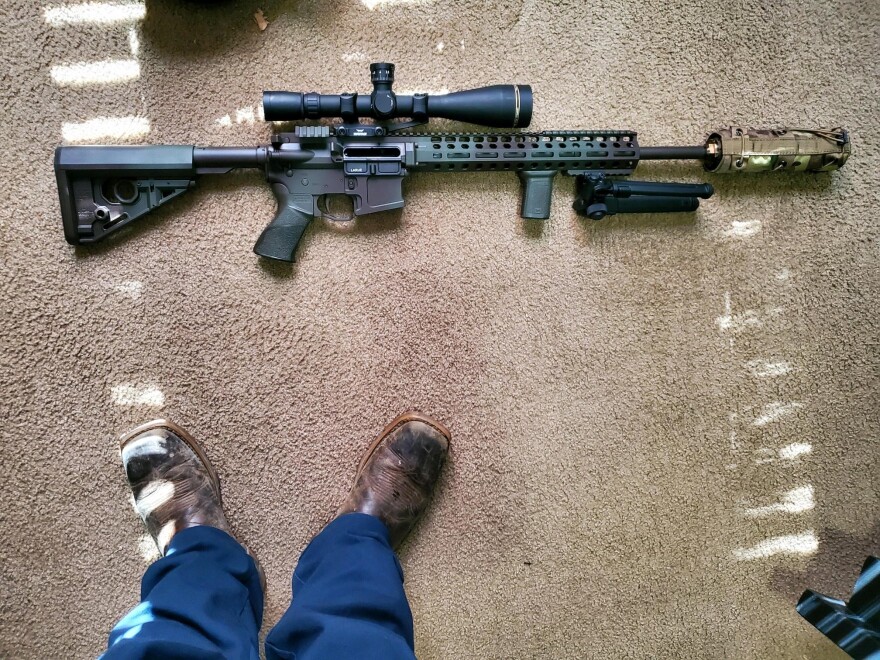In mid-August, they panicked. By that point, prosecutors allege they’d been talking for months, batting around ideas, honing a plan. They’d found each other through a network of connections inside the world of Michigan militias. Even in that world, full of people who love guns and hate the government, they were extreme. They threw around ideas no one else would consider. Storming the state Capitol building in Lansing. Destroying police vehicles with “Molotov cocktails.” Kidnapping a governor.
But in August, they got word a police officer had been asking questions of one of their former roommates, and everything seemed like it might unravel. They messaged each other frantically on a secure app.
“you think we’ve got a fed???” one of them texted.
The question glowed on a large screen inside a darkened federal courtroom in Grand Rapids this week, answering itself.
Yes, it turned out, they had a fed. Plus another fed. Plus two more confidential informants. The government had been following their alleged plan every step of the way.

The evidence
The U.S. Attorney’s Office for the Western District of Michigan laid out the extensive evidence it collected on the group during a two-part preliminary hearing in federal court in Grand Rapids on Tuesday and Friday. Late Friday, the office released its exhibits to the public: 24 files containing screenshots of text messages, videos, and audio recordings of the men as they fine-tuned their alleged plan from early June to early October, when they were arrested.
Prosecutors say the men were motivated by a belief that society is on the brink of collapse, and a new civil war is imminent. They didn’t all share the same political beliefs, but they raged against government and had a particular hatred for Governor Gretchen Whitmer, who they called a “tyrant.”
Taking her down became their goal, prosecutors allege.
[For more Michigan news right on your phone, subscribe to the Stateside podcast on Apple Podcasts or Google Podcasts today]
The five men who appeared in federal court this week are among 14 who’ve been charged in the alleged plot.
Adam Fox, Ty Garbin, Brandon Caserta, Kaleb Franks and Daniel Harris all appeared in federal court this week. A sixth man, Barry Croft, is a resident of Delaware. His case is currently being moved to Michigan.
In an affidavit filed last week, FBI Special Agent Richard Trask said law enforcement first became aware of the men’s plot following a meeting in Dublin, Ohio on June 6.
"The group decided they needed to increase their numbers," says the federal affidavit.
Trask testified Tuesday that militia members from four or five states attended the meeting, and the FBI had informants present. That’s when they first learned that Adam Fox and Barry Croft discussed the possibility of taking out a sitting governor.
At first, the plan was amorphous, Trask said. The men talked about kidnapping Ralph Northam, the Democratic governor of Virginia, or Governor Whitmer in Michigan. Whatever steps they decided to take, they knew they couldn’t do it alone, according to Trask.
“The group decided they needed to increase their numbers and encouraged each other to talk to their neighbors and spread their message,” Trask wrote in the affidavit submitted to the court.
The affidavit says that's when Adam Fox reached out to a militia known as the Wolverine Watchmen.

Watching the Watchmen
Fox first reached out to its members on Facebook, according to Trask, but the men met in person not long after. On June 18, Fox went to a Second Amendment rally at the state Capitol Building in Lansing. He appears in many videos from that day, alongside other militia members. A reporter for WOOD-TV spoke to Fox while he stood with Pete Musico and Joseph Morrison. Musico and Morrison are among the men charged in state court over the alleged plot. Affidavits from the Michigan State Police identify the pair as founders of the Wolverine Watchmen.
The day of the rally, prosecutors say Adam Fox pushed the idea of storming the Capitol, overtaking it by force. According to Trask’s affidavit, he proposed the idea to Ty Garbin, another member of the Wolverine Watchmen who also attended the rally.
Garbin “was not interested at all in storming the Capitol,” said Gary Springstead, an attorney for Garbin who questioned Trask on Friday.
But the affidavit says the men continued talking anyway, meeting just two days later in Grand Rapids, in the basement of a vacuum repair shop where Fox lived.
Through it all, the government’s informant was in the loop: watching, listening, recording.
"There's nothing wrong with being upset with your government, or your governor," said assistant U.S. Attorney Nils Kessler.
Throughout July, the men continued to meet. Some were added to the group. Eventually, at least a few dropped out.
The weekend of July 10-12, a number of the men allegedly involved in the plot attended a militia training in Cambria, Wisconsin. One video shows two men practicing getting out of a car and shooting at a target. Trask says one of the men is Brandon Caserta. Caserta’s attorney says there’s nothing illegal about having a gun and attending a training.
In fact, much of what the men did in the months between June and when they were arrested in October was perfectly legal on its own.
“There’s nothing wrong with being upset with your government, or your governor,” argued assistant U.S. Attorney Nils Kessler in court on Friday.
What makes it criminal, Kessler argued, is the “totality of the circumstances” over time. And, over time, Kessler says what emerged wasn’t just idle talk of storming a Capitol building or firebombing police cars. It was the honing of a specific, actionable plan.
By July 27, the FBI alleges Fox had settled on one plan in particular: kidnapping the governor at her vacation home.
“FOX said their best opportunity to abduct Governor Whitmer would be when she was arriving at, or leaving, either her personal vacation home or the Governor’s official summer residence,” the federal affidavit alleges. “FOX described it as a ‘Snatch and grab, man. Grab the f-----’ Governor. Just grab the b-----. Because at that point, we do that, dude -- it’s over.’”

The panic
In the spring and early summer, it wasn’t hard to find the alleged conspirators. A few of them appear in videos taken at the Capitol as early as April 30. They appear again on June 18. They went to large training events with others in the militia world.
But by August, they decided they had something to hide. They stopped communicating via Facebook and switched to a new app called Wire. The app offers end-to-end encryption, meaning no one outside of the conversation can gain access, not even the app developer.
“Operational security” became a concern, Kessler alleges.
Then they found out one of their own had slipped up.
“Guys, the cops just questioned my old roommate about me,” says a person listed as “Doc” in the group chat.
Prosecutors identified “Doc” as Paul Bellar, of Milford, who’s been charged in state court. Bellar had just moved. He left something behind, perhaps a photo of himself, that aroused suspicion.
“Apperently [sic], they were asking him about my military pictures, and my actions in the ‘boogaloo’ movement,” Bellar wrote.
Police, it seemed, also knew about code words the group had been using on the chat, to hide their plans.
“[W]orst case there’s someone in here who isn’t very cash money,” wrote one of the men in the group, identified by prosecutors as Kaleb Franks.
“[Y]ou think we’ve got a fed?” Bellar responded.
They weren’t sure. But they were panicked.
“In person talks only from now on,” Franks responded.
Daniel Harris instructed them to meet that weekend, at the house where he lived, in Lake Orion, according to the federal complaint. They each had to bring three forms of identification to prove each of them were who they said they were.
The informant was who he said he was. So he stayed in the group.
After the meeting, they set up a new encrypted chat group to avoid “law-enforcement infiltration.” The informant was included in the new group, and the plan continued on.

The plan
One thing prosecutors say the men decided on at their in-person meeting in Lake Orion: They needed to be better prepared to pull off their plans.
The following Saturday, August 29, Adam Fox traveled up north to try to find the governor’s vacation home. The informant went with him.
This week in court, prosecutors showed pictures they say show Fox, standing at the edge of a lake, looking out with binoculars to try to spot the governor’s residence. They say he also drew a map of the area, showing the nearest police station, with an estimate of how long it would take for police to respond.
According to prosecutors, the governor wasn’t the only person potentially in danger from the plot.
“We ain’t gonna let ‘em burn our f------’ state down,” Fox told the informant during the trip up north, according to the federal affidavit. "I don’t give a f--- if there’s only 20 or 30 of us, dude, we’ll go out there and use deadly force.”
Brandon Caserta was even more explicit.
In a video prosecutors say was recorded in October, just before the group’s arrest, Caserta advocates killing any police officers who get in their way.
“I’m taking out as many of those motherf------ as I can,” Caserta says in the video.
“I’m sick of being robbed and enslaved by the state, period. I’m sick of it,” he continues. “And these are the guys who are actually doing it.”
Federal Magistrate Judge Sally Berens described the video as “really very chilling” and cited it when she ordered that Caserta must remain in the custody of the U.S. Marshals while the case proceeds.
But again, Caserta’s attorney argued, his client didn’t break the law when he told the group he wanted to kill cops.
“Maybe it is inflammatory rhetoric,” argued attorney Michael Hills, who is representing Caserta. “But it is perfectly legal.”
"Maybe it is inflammatory rhetoric. But it is perfectly legal."
“Big talk between crackpots,” said attorney Scott Graham, who represents Kaleb Franks.
“We’re talking about guys who want to run around in the woods with guns and say bad things about the government,” said attorney Mark Satawa, who represents Ty Garbin.
To the federal law enforcement watching the men’s every move, though, what happened went well beyond words.
After Fox checked out the governor’s residence on August 29, he and others planned a second trip to scope out the area, this time at night. The group was much larger this time, according to prosecutors. The men traveled in three cars, the evening of September 12, into the early morning of the 13th.
One of the men, identified by prosecutors as Brian Higgins of Wisconsin, recorded the trip on his dash cam and gave the footage to the informant at the end of the night. From that footage, U.S. Assistant Attorney Nils Kessler said they could see exactly who was in the car and where they went.
“They drove right up to the house,” Kessler said.
This, he said, is when the plot went well beyond just talk, and became something more sinister.
“If you’re not on board with this plan,” Kessler argued, “you don’t case the governor’s house at night.”
In fact, Kessler says, two of the men tried to walk away from the plot after that night. One of them is Higgins, who has now been arrested and faces charges in state court.
Another man, Eric Molitor, also stepped back, saying he “didn’t want to go to jail,” according to Kessler. Molitor also faces charges in state court for taking part in the surveillance.
The men who remained, and continued to talk about the plot in their encrypted group chat, were the core group, according to prosecutors. They’re the ones facing possible federal charges, and who could spend the rest of their lives in prison, if convicted.

The undercover agent
In late September, prosecutors say, there was still one more part of the plan the men hadn’t quite figured out. They had settled on trying to kidnap the governor while she was at her home up north. And they wanted to take her somewhere – possibly to another state, possibly out to the middle of Lake Michigan, where they would abandon her.
They had the weapons and the people to do it. But they wanted one more thing: explosives.
The idea, according to prosecutors, was to blow up a bridge near the governor’s house, in order to cut off the road to the nearest police station.
At other stages, some men close to the group had experimented with making improvised explosive devices, according to the federal affidavit. But these wouldn’t be nearly big enough to take down the bridge. So they brought in someone from the outside.
It was the informant who brought him in, according to FBI agent Trask. And the person he brought in was an undercover FBI agent.
This agent, who the men came to know as “Red,” told them they’d need $4,000 to pay for the explosives to take down the bridge.
It was a steep price for the men, but some were determined to scrape the money together, prosecutors say.
In the meantime, they committed to do one more training session. But to Adam Fox, at least, the time was growing short. He wanted to do the kidnapping before the November 3 election. When the men talked about doing their final training in late October, Fox pushed back, according to Trask.
“It would only leave three days until the election,” Trask said of the initial idea. So Fox suggested moving the training a week earlier.
Before the training, Fox bought a Taser, according to the federal affidavit. He showed it off to the group in a video.
But the final training never happened, and the Taser never got put to use.
The set up
Daniel Harris seemed nervous.
It was October 7, and he was in the back seat on the road to see “Red,” the explosives expert who was going to show the group some new gear and possibly take a down payment on enough explosives to destroy a bridge.
Harris, a Marine Corps veteran, played with his semi-automatic pistol during the ride, loading, unloading, clicking the trigger, re-loading, unloading and clicking again.
The man in the driver seat was a man Harris thought he knew well, a man who’d been along for this alleged plot almost since the beginning. What Harris didn’t know is the man was also a confidential informant for the FBI. And the man he was taking them to meet was an undercover agent.
The man in the front seat told Harris to stop playing with his gun. Instead, Harris pointed it at his head, and held it there.
“Get that thing away from me,” the informant finally snapped, according to FBI agent Trask, who told the story in court on Tuesday.
That day, a Wednesday, the alleged plot to kidnap Michigan’s governor came to an end. Fox, Garbin, Harris and Frank were arrested at the spot where they thought they were meeting Red. Caserta was picked up at his job. Barry Croft was arrested in Delaware and is now in the process of being transferred to Michigan for his case to be heard. Eight other men, including Eric Molitor, Pete Musico, Joseph Morrison, Paul Bellar and Brian Higgins all face charges for “providing material support for a terrorist act,” among other charges.
This week in federal court, defense attorneys tried to argue it was never a real “plot” to begin with, only talk.
And what was the plan anyway? To take the governor – and what?
Fox said he wanted to leave the governor in the middle of Lake Michigan, according to Trask. Others talked about conducting a trial in another state. A few times, the men talked about killing her.
“When you look at those facts, they don’t make sense,” said attorney Scott Graham, who said the men never agreed on a plan for what they would do.
“Was it a good plan? Had they thought it through?” responded Kessler. “No, it doesn’t look like they did.”
“They got caught because they were amateurs.”
Despite the arguments from the defense attorneys, magistrate judge Sally Berens decided there was enough evidence – much of it recorded by the confidential informant – for the men to remain in detention while they await the next step of what could be a long march toward trial. Next, members of a grand jury will take a look at the evidence and decide what, if any, charges to bring against the men.
Want to support reporting like this? Consider making a gift to Michigan Radio today.






